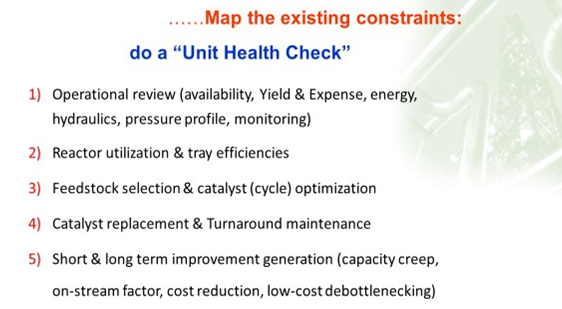HydroDeSulphuriser (under)performance investigation
ULSD operation environment
In today’s 10 ppm Ultra-Low Sulphur Diesel world, the HydroTreater (HT) or HydroDeSulphurisation (HDS) unit has become an upgrader with an appreciable contribution to the Refinery Margin. Some of them were recently built, some of them are decades old and have been revamped to the new specifications, but the incentive to improve on their bottom line will not disappear. Underperformance is costly and effective troubleshooting is required to quickly recover the lost margin in a sustainable manner.
Unit health check - optimal catalyst performance
Unless a problem has clearly manifested itself – such as a pressure drop issue – it is wise to carry out a performance or health check every 1-2 years.
Such a health check evaluates the unit at various levels:
1.Daily operation
2.Reactor Internals
3.Catalyst cycle & feedstock optimisation
Findings can also be input for longer term optimisation, such as the next cycle catalyst selection and/or future revamp options.
1.Daily operation
2.Reactor Internals
3.Catalyst cycle & feedstock optimisation
Findings can also be input for longer term optimisation, such as the next cycle catalyst selection and/or future revamp options.
Operational review
A check on daily operation focusses on the following 4 aspects:
1.Review of unit planned and un-planned down-time can bring up options to improve unit availability.
2.Review of the unit energy use by checking the heat-exchanger duties, furnace efficiency and steam use.
3.Yield check: this can be improved if the separation of slops in the work-up section is poor. For example, reducing give-away on Flash Point is a way to boost product yield.
4.For the unit integrity its water balance needs to be reviewed to ensure that the ammonium salts that are produced in the reactor are continuously being removed.
1.Review of unit planned and un-planned down-time can bring up options to improve unit availability.
2.Review of the unit energy use by checking the heat-exchanger duties, furnace efficiency and steam use.
3.Yield check: this can be improved if the separation of slops in the work-up section is poor. For example, reducing give-away on Flash Point is a way to boost product yield.
4.For the unit integrity its water balance needs to be reviewed to ensure that the ammonium salts that are produced in the reactor are continuously being removed.
Reactor utilisation
The catalytic reactions in the reactor are the heart of the HDS. The catalyst requires the optimum temperature profile and uniform trickle flow conditions
during its life cycle and the reactor internals need to safeguard this. A review of the tray hydraulics using, among others, quench test data can ensure
this.
Secondly, a check of the loading diagram is required to assess maximum catalyst activity as well as its resistance against fouling.
Upgrading conventional trays with State-of-the-Art ones can easily add 20% catalyst activity. This activity increase can then be used to extend catalyst life or increase feed rate/heaviness, assuming extra H2 is available.
Secondly, a check of the loading diagram is required to assess maximum catalyst activity as well as its resistance against fouling.
Upgrading conventional trays with State-of-the-Art ones can easily add 20% catalyst activity. This activity increase can then be used to extend catalyst life or increase feed rate/heaviness, assuming extra H2 is available.
Catalyst cycle & feedstock optimisation
Daily optimisation normally centres on the catalyst as changes in feedstock and catalyst aging requires continuous tuning of the reactor temperature to
ensure on-spec product. Using the daily & weekly feed and product analyses, the reactor average temperature can be normalised to a reference or
design condition, and this normalised temperature will show the catalyst deactivation over time, allowing cycle length prediction. This normalised
catalyst activity plot will also allow testing of so-called “what-if” scenarios, in which feed rate and/or severity is varied. This can be used to
maximise unit margin over the cycle as a whole.
Summarising
An HDS Health Check will allow for fine-tuning of equipment in daily operation as well as for extracting maximum benefit from the catalyst load.
Catalyst-Intelligence is a consulting company providing independent & comprehensive advice on fixed bed catalysts to refineries and petrochemical
plants. For more information on how we can help you we refer to our website: www.catalyst-intelligence.com


